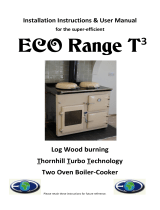
10
3.- DIRECTIONS FOR USE
The manufacturer accepts no liability with regards to the deterioration of parts caused by the use of
incorrect fuels or unauthorised modifications made to the appliance
Only use original replacement parts
All national and local building regulations
must be respected during the installation of
this appliance.
Use of the appliance in warm weather (warm
days, early hours of the afternoon on sunny
days) may lead to lighting and up draught
problems.
In certain weather conditions such as fog or
extremely cold weather, there may not be
sufficient draft in the flue to operate the
appliance correctly and fumes may re-enter
the room. In these instances we do not
recommend that you operate the appliance
until the weather conditions have improved.
3.1. Fuel
This appliance is not an incinerator.
• Use dry logs (16 % humidity), cut at least
two years ago, clean of resin and stored
in a sheltered, ventilated place.
• Use hard woods with high calorie values
and good ember production.
• Large logs should be cut to useable
length before being stored.
• Finely-chopped wood produces greater
heat output, but also burns more quickly.
Optimum fuels recommended
• Oak and beech
Other recommended fuels
• Dry seasoned or Kiln dried wood
• Coal and smokeless coal
Non-permitted fuels:
• Petroleum coke and liquid fuel.
• “Green wood”. Green or damp wood
reduces the performance of the appliance
and leads to soot and tar build-up on the
inner walls of the gas flue, obstructing it.
• “Recovered wood”. The burning of
treated woods (railway sleepers,
telegraph posts, plywood, fibreboard,
pallets, etc.) quickly blocks the system
(soot and tar build-up), harms the
environment (pollution, smells) and may
lead to deformation of the firebox due to
overheating.
• Pine and eucalyptus logs are low density
and produce very long flames, the parts
of the cooker wearing out more quickly
than normal.
• All types of plastic, spray cans, etc.
“Green and reprocessed wood may
cause chimney fires”.
3.2. Lighting your cooker
Proceed as follows in order to light the cooker
satisfactorily.
• Control “C” must be fully out (direct
draught open).
• Primary air inlet “E” should also be open
(Rotate fully clockwise)
• Secondary air inlet “F” should also be
fully open (side all way to right).
• Flue damper slide “G” should be fully
open.
• Place a ball of paper or a firelighter and
some wooden chips in the firebox.
• Light the paper or firelighter and leave
the door ajar. The door has two closed
options: fully closed or ajar (two finger
breadths). Leave the door ajar until the
fire gains strength (about 20 minutes).
• When the fire is burning strongly, load
the firebox with dry logs and close the
door fully. Also close the Direct Draught
(C).
Fig. 7






















